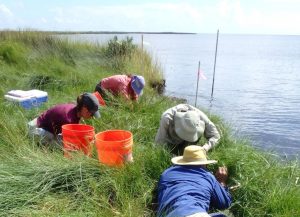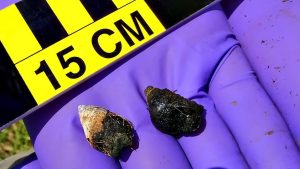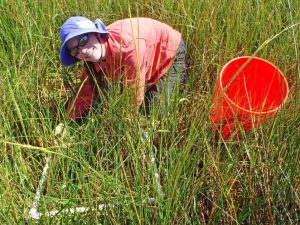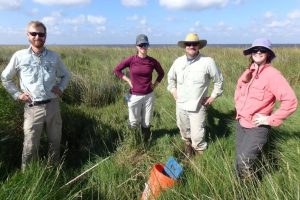Five-Year Study Finds Deepwater Horizon Negatively Affected Periwinkle Snails
– FEBRUARY 28, 2017
Scientists conducted a meta-analysis on marsh periwinkle snails using data spanning five years to investigate how the oil spill affected them over time. The researchers found that snails from heavily-oiled sites exhibited decreased density and shell length. There were greater relative proportions of small adults and fewer large adults in heavily-oiled sites compared to reference sites. These results suggest that the Deepwater Horizon spill suppressed periwinkle populations and that recovery was slowed or incomplete. The researchers published their findings in Marine Ecology Progress Series: Five years of Deepwater Horizon oil spill effects on marsh periwinkles Littoraria irrorata.
Periwinkle snails are an abundant salt marsh species that influence estuarine food webs and ecosystem productivity. Negative impacts on periwinkles could affect other marsh species and the overall marsh structure and function. Researchers synthesized published and unpublished data from 2010 – 2015, comparing northern Gulf of Mexico periwinkle populations in heavily-oiled seaward marsh edges (~0-6 meters from the shoreline), the oiled marsh interior (~6-15 meters from the shoreline), and the marsh interior with light-to-no visible oiling (>15 meters from the heavily oiled shoreline).
The population densities of periwinkles declined an average of 73% at heavily-oiled sites, with moderate recovery that leveled off and remained below reference values during 2013 – 2015. Population density declined in the oiled-marsh interior areas from 2010 – 2011, but recovered by 2012. There were no observed effects to population density in the marsh interior with light-to-no visible oiling. Periwinkle shell lengths shortened in 2011 at heavily-oiled sites, then appeared recovered by 2012, but exhibited a declining trend through 2015. Shell sizes in the marsh interior areas were unaffected. The differences in size distribution among oiled and reference sites suggest low recruitment and/or poor survival of early recruits.
The researchers proposed that periwinkle population recovery may take several years due to effects from residual oil in marsh soils, ongoing recovery of the marsh vegetation, and the time required for snail recruitment, immigration, and subsequent growth to rebuild populations. Their study emphasizes the need for continued, long-term population monitoring.
NRDA data used in this paper are publicly available at https://dwhdiver.orr.noaa.gov. GoMRI data are publicly available through the Gulf of Mexico Research Initiative Information & Data Cooperative (GRIIDC) at doi: 10.7266/N7FF3Q9S. Data from McCall & Pennings (2012) are publicly available at http://dx.doi.org/10.6073/pasta/8da296e41363a8fcb931d44a71264107.
The study’s authors are Scott Zengel, Jennifer Weaver, Steven C. Pennings, Brian Silliman, Donald R. Deis, Clay L. Montague, Nicolle Rutherford, Zachary Nixon, and Andrew R. Zimmerman.
************
This research was made possible in part by grants from the Gulf of Mexico Research Initiative (GoMRI) to the Florida Institute of Oceanography for the project Biodegradation of the Deepwater Horizon Oil in Florida Marsh Ecosystems and Exploration of Novel Passive Remediation Strategies and the Louisiana State University Department of Oceanography and Coastal Sciences for the projects Accelerating Recovery after the Deepwater Horizon Oil Spill: Response of the Plant-Microbial-Benthic Ecosystem to Mitigation Strategies Promoting Wetland Remediation and Resilience and Long-Term Impact, Recovery and Resilience: Wetland plant-microbial-benthic ecosystem responses to the Deepwater Horizon oil spill and mitigation strategies promoting sustainability. Other funding sources include the National Oceanic and Atmospheric Administration, the State of Louisiana, and the National Science Foundation.
The Gulf of Mexico Research Initiative (GoMRI) is a 10-year independent research program established to study the effect, and the potential associated impact, of hydrocarbon releases on the environment and public health, as well as to develop improved spill mitigation, oil detection, characterization and remediation technologies. An independent and academic 20-member Research Board makes the funding and research direction decisions to ensure the intellectual quality, effectiveness and academic independence of the GoMRI research. All research data, findings and publications will be made publicly available. The program was established through a $500 million financial commitment from BP. For more information, visit https://gulfresearchinitiative.org/.
© Copyright 2010-2017 Gulf of Mexico Research Initiative (GoMRI) – All Rights Reserved. Redistribution is encouraged with acknowledgement to the Gulf of Mexico Research Initiative (GoMRI). Please credit images and/or videos as done in each article. Questions? Contact web-content editor Nilde “Maggie” Dannreuther, Northern Gulf Institute, Mississippi State University (maggied@ngi.msstate.edu).









